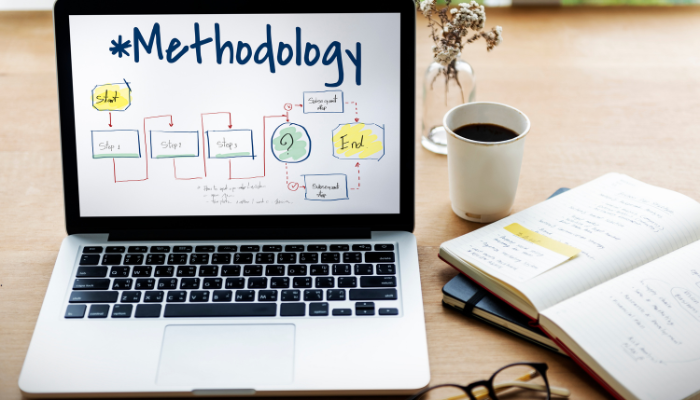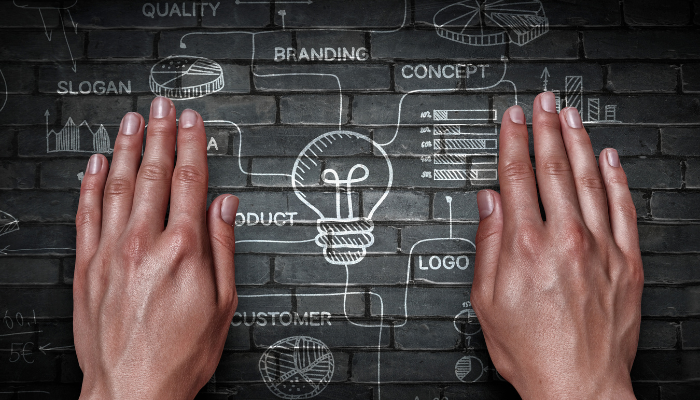Have you ever wondered why some products feel tailor-made for you while others leave you frustrated?
The secret often lies in the design thinking process—an approach that digs deep into user needs and crafts solutions that genuinely address their challenges. In fact, the Design Value Index highlights that companies integrating design thinking see a 228% increase in performance compared to others.
In this guide, we’ll explore the five stages of the design thinking process—Empathy, Definition, Ideation, Prototyping, and Testing—delve into the tools you can use and understand why the design methodology is essential for your business’s growth.
Source: design methodology Process
What is Design Thinking?
Design thinking is a systemic, customer-focused problem-solving approach that blends logic, intuition, and empathy to tackle complex challenges. It’s about envisioning ideal future outcomes and crafting solutions that truly connect with your users.
As Jennifer Kilian, a McKinsey Partner, states, design thinking offers a significant competitive advantage by fostering customer loyalty, leading to innovative and impactful outcomes.
Know more about what design thinking is by reading: Design Thinking – Why it Matters – Codewave Insights.
Why is Design Thinking Essential for Your Business?
Design thinking offers a clear path to a competitive edge by putting real user needs at the forefront.
Research shows that design-led companies achieve nearly double the revenue growth and investor returns compared to their industry peers. Take Sephora, for example—they noticed customers turned to YouTube for tutorials, so they introduced their own videos, successfully retaining customers on their platform.
By integrating design thinking, you create products and services that resonate, driving long-term growth and loyalty.
Now, let’s look at the stages of the design methodology process to understand how it all comes together.
Stages of Design Methodology Process
By leveraging these five stages—Empathy, Definition, Ideation, Prototyping, and Testing—you’ll be equipped to create products and services that not only meet but exceed your customers’ expectations.
Let’s break down each stage of the design methodology, providing practical insights and tips on implementing them successfully.
Stage 1: Empathize—Research Your Users’ Needs
The first step in the design methodology process is to immerse yourself in your users’ world to understand their needs, frustrations, and motivations truly. This stage is crucial because it ensures your design solutions are grounded in real experiences, making them more relevant and effective.
A. Gain an Empathetic Understanding of the Problem
Start with an empathy map to help visualize what your users say, think, feel, and do. This structured framework lets you capture nuanced insights about your users’ emotions, behaviors, and challenges, which you might otherwise miss.
You can also spend time shadowing your users in their environment. For example, watch how customers interact with banking apps to identify frustrations or delays.
B. Consult Experts and Conduct Observations
Reach out to stakeholders or professionals who are well-acquainted with your target audience. Their insights can help you understand users’ broader challenges within your industry.
Observe users in their natural settings over a period of time as part of the design methodology. For example, if your target audience is office professionals, observe their workflow to identify inefficiencies or pain points that your solution can address.
Do you feel like your customers are lost tourists on your website? Codewave‘s Customer Journey Redesign service can help you map out their experience and identify any confusing detours. We’ll use a combination of expert consultations and user observations to:
- Understand your target audience and their challenges within your industry.
- Observe how users interact with your product or service to identify any pain points or areas for improvement.
C. Engage and Empathize with Users Directly
Rather than just asking generic questions, use contextual inquiries as part of your design methodology, where you ask users to perform specific tasks while sharing their thoughts. This gives you actionable insights into how they interact with your product or service.
Create detailed journey maps that track each step users take while interacting with your solution. This helps identify touchpoints where they experience difficulties, allowing you to address these areas effectively.
D. The Importance of Empathy in a Human-Centered Design Process
Empathy, a key aspect of the design methodology, ensures your design solutions are rooted in a genuine understanding of your users. By focusing on their needs and emotions, you can create products that offer genuine value, fostering user satisfaction and loyalty.
Host Empathy Workshops—Bring your team together for empathy-building workshops where you share user insights, discuss pain points, and brainstorm potential solutions.
Pro Tip: Conduct role-playing exercises in which team members assume the user’s role. Check out Codewave’s design workshops and include such exercises to build deeper empathy within your team.
Stage 2: Define—State Your Users’ Needs and Problems
In the Define stage of the design methodology, you organize and make sense of the insights gathered during the Empathize phase. This step is crucial for pinpointing the exact problems you need to solve.
A. Organize Information Gathered During the Empathize Stage
Start by using an Affinity Map to group information based on themes or patterns. This will help you spot trends in user behaviors or pain points. For example, cluster insights from users struggling with a feature to highlight the issue. Use tools like Miro or MURAL for digital mapping. Then, create Insight Statements to convert raw data into actionable insights, such as “Users abandon carts due to a complex checkout process.
B. Analyze Observations to Define Core Problems
Use the “5 Whys” Technique to dig deep into user issues by repeatedly asking “why” until you reach the root cause. For instance, if users abandon your platform, you may find it’s due to limited payment options. Then, create User Insight Statements to clearly summarize the problem, like: “Users abandon carts due to difficulty finding their preferred payment method.”
C. Define the Problem Statement in a Human-Centered Manner
Apply the “How Might We” (HMW) Format to turn challenges into opportunities, e.g., “How might we simplify the product search experience for our users?” This encourages solution-oriented thinking.
Next, use the POV (Point of View) Framework within the design methodology: [User] needs a way to [user’s need] because [insight]. For example, “Busy professionals need a way to manage finances on the go due to time constraints with traditional banking.”
Source: What is How Might We (HMW)? — updated 2024 | IxDF
Stage 3: Ideate—Challenge Assumptions and Create Ideas
The Ideate stage in the design methodology is where creativity comes into play. This is your chance to break free from conventional thinking and investigate a range of possibilities.
A. Generate Ideas for Solutions
Begin with Brainstorming Techniques to spark creativity. Try Brainwriting, where participants silently write ideas before sharing them, ensuring diverse input. Additionally, use the SCAMPER Technique (Substitute, Combine, Adapt, Modify, Put to another use, Eliminate, Reverse) to challenge conventional thinking and explore fresh ways to approach the problem.
B. Build on Understanding Users and Defining Problems
Try the “Crazy 8s” Exercise, where you fold a piece of paper into eight sections and sketch different ideas in each within eight minutes, pushing you to explore diverse solutions quickly. Also, revisit User Personas and Journey Maps from earlier stages to ensure your ideas align with users’ needs, challenges, and behaviors, maintaining a user-focused approach.
C. Look at the Problem from Different Perspectives
Use Role-Storming to generate ideas by viewing the problem from different stakeholders’ perspectives, such as customers or competitors. For example, think about how a beginner user might interact with your product. Additionally, apply Reverse Thinking by asking, “How can we make the product experience worse?” This helps uncover hidden areas for improvement.
Stage 4: Prototype—Start to Create Solutions
Prototyping is the process within the design methodology that turns ideas into tangible models. The aim is to create simple, testable versions that allow quick validation and iteration.
Read in detail about Prototyping in Design Thinking
A. Produce Inexpensive, Scaled-Down Product Versions
Begin with Low-Fidelity Prototypes using tools like Balsamiq or paper sketches to visualize ideas quickly with minimal cost. For physical products, create Physical Models using materials like cardboard or foam to test functionality and form efficiently. This approach enables rapid exploration without significant investment, allowing for quick adjustments based on feedback.
B. Investigate Key Solutions from the Ideation Phase
Develop Interactive Prototypes using tools like Figma or InVision for detailed, clickable designs that mimic real user interactions. Use Figma’s Auto Layout for responsive designs, ensuring effective device testing. Test multiple prototypes side by side to quickly identify the most effective design elements, streamlining the selection of the best solution.
C. Conduct Experimental Phases to Identify the Best Solutions
Engage in Rapid Prototyping with tools like Adobe XD or Sketch to quickly adapt based on feedback. Implement A/B Testing by presenting different prototypes to users, comparing which version performs best, and refining your solutions accordingly. This approach ensures you identify the most effective design.
By identifying and eliminating user roadblocks early on, you can launch a product that’s polished, intuitive, and sets you up for success. Visit Top QA testing services | Codewave to learn more about how we can help you make a flawless first impression.
D. Test Prototypes Within the Team and with External Users
Start with Internal Testing by sharing prototypes with your team to identify issues early and ensure alignment. Then, gather feedback from real users using tools like UserTesting or Lookback to observe interactions. Apply the Cognitive Walkthrough method, where users verbalize their thoughts, helping you understand how intuitive your design truly is.
By the end, you’ll have tested prototypes that are aligned with user needs and ready for refinement.
Stage 5: Test—Try Your Solutions Out
In the Testing stage of the design methodology, you validate your prototypes with real users, ensuring they address the problems identified earlier and function effectively.
A. Rigorous Testing of the Complete Product
Allow users to interact with your prototype independently to evaluate its intuitiveness and effectiveness. Focus on how well it meets their needs and solves pain points. Utilize tools like UsabilityHub or Maze for structured user feedback, which will help you identify areas that need improvement and refine the final design accordingly.
B. Use Best Solutions Identified from Prototypes
Integrate the most successful solutions identified during the design methodology prototyping, refining them based on continued testing to ensure they meet user expectations. Use tools like JIRA or Trello to track changes, feedback, and progress efficiently. This approach helps maintain organization, ensuring your final design delivers the desired outcomes and addresses user needs effectively.
Want to test like a pro without breaking a sweat? Codewave’s Automation Testing service streamlines the entire process. Get real-time feedback, automate repetitive tasks, and ensure your product hits the mark every time.
C. Results Often Lead to Redefined Problems
Embrace Iterative Refinement, as testing often reveals new challenges that guide ongoing improvements. This is a natural part of the design process. Utilize Daily Scrums with Slack integrations for real-time updates, enabling your team to address issues promptly and adapt the design for continuous enhancement. This approach ensures a user-centric final product.
D. Iterative Process for Deep Understanding of Product and Users
Implement Continuous Integration (CI) with tools like Jenkins or CircleCI to automate testing and deployment, ensuring constant validation as you refine your product. Enhance this process using AI-assisted tools like GitHub Copilot to improve code quality and productivity during iterations, ensuring your product evolves efficiently based on user insights.
Now, let’s uncover the non-linear nature of design methodology and how it shapes innovation.
The Non-Linear Nature of Design Methodology
The design methodology is not a rigid, step-by-step process; it’s flexible and non-linear, adapting to your needs.
A. Flexible and Iterative Approach:
Each stage is revisited when needed. You can return to the Empathize stage if new insights emerge during prototyping. This adaptability prevents rigid solutions, leading to more effective designs. Furthermore, this flexibility encourages creativity, allowing your team to explore alternative solutions without limitations.
B. Concurrent Stage Execution:
Teams often handle multiple stages simultaneously. For example, while one team tests the prototype, another might refine the ideation. This concurrent execution accelerates the process and enables a seamless flow of insights across stages, ensuring all team members contribute meaningfully to each design aspect.
C. Continuous Refinement:
Design is an ever-evolving design methodology that requires continuous feedback and adaptation. As you collect feedback from users, your design should adapt and improve. Implementing agile frameworks like Scrum or Kanban not only manages overlapping tasks efficiently but also promotes a culture of ongoing learning and improvement within your team.
As we move forward, let’s discuss why adopting a user-centric approach is crucial for success.
The Importance of a User-Centric Approach
A user-centric approach ensures your designs genuinely solve user problems and provide value.
1. Emphasis on User Insights:
Prioritize user feedback at every stage of the design methodology. Regularly involving users ensures your design remains relevant and addresses their pain points. Additionally, this emphasis helps build empathy within your team, fostering a deeper understanding of the challenges your users face, leading to more intuitive solutions.
2. Collaborative Engagement:
Involve users throughout the design process, from ideation to testing. This continuous involvement ensures your product stays practical and users feel a sense of ownership. It also minimizes the risk of misalignment between the final product and user expectations, reducing costly revisions later.
3. Iterative and Human-Centered:
Design isn’t a one-time effort within the design methodology; it’s a process that evolves with user interactions. Continuously refine your designs based on real feedback. Utilize tools like Hotjar or SurveyMonkey to gather actionable insights. These insights validate your design choices and help you identify hidden opportunities to enhance user experiences further.
Conclusion
The design methodology involves five dynamic stages: Empathize, Define, Ideate, Prototype, and Test. Its non-linear and user-centric nature makes it adaptable and effective. Here’s a comprehensive list of the Best Online Tools for Design Thinking Stages in 2024
Remember: Each stage can be revisited, refined, and improved, ensuring your designs align with user needs and business goals.
Ready to apply these principles to your next project? At Codewave, a Design Thinking-led Digital Innovation company, we believe that our everyday encounters with people connected to us at work can lead to profound exchanges and opportunities for growth. We specialize in helping businesses leverage design methodology to create impactful, user-centered solutions.
Check out our winning work in design, and contact us today to see how we can assist you in your design journey. Also read: Top 7 Influential Design Companies Around the World.
Codewave is a UX first design thinking & digital transformation services company, designing & engineering innovative mobile apps, cloud, & edge solutions.






